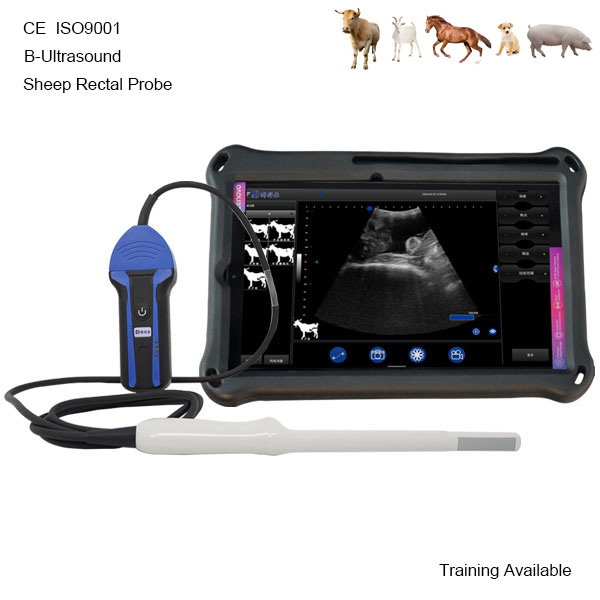Method for Examining Pregnancy in Small-tailed Han Sheep Using Ewe Ultrasound
Turn on the Ewe Ultrasound machine and enter the examination program. First, locate the fluid-filled bladder (with clear edges, located below the rectum) in the ultrasound image. Then, using the bladder as a reference, rotate and move the probe left, 右, and forward to locate the uterus. Fix the desired image, measure or process as necessary using the electronic ruler provided with the Ewe Ultrasound machine, and then save the image for later imaging. After observing fetal reflexes and fetal heartbeats, perform rectal examinations every two days to monitor fetal development. During this period, combine rectal examinations with abdominal wall scans until the fetus is completely submerged in the abdominal cavity and cannot be detected by the rectal probe. Then, monitor fetal development using only abdominal wall scans.

The abdominal wall scan method uses a 3.5MHz Ewe Ultrasound fan-shaped probe. The sheep is placed supine and restrained on a self-made restraint frame, with an assistant holding down the limbs for restraint. In early and mid-pregnancy, external examination is mainly performed in the sparsely haired area around the udder or the right inguinal abdominal wall area. During the late second trimester and late third trimester, due to the increased fetal size, the probe area of the Ewe Ultrasound machine should be moved forward, generally to an area 4-6 cm wide above the udder. しかし, each time, the hair at the examination site needs to be shaving and a coupling agent applied before examination. These placental processes can be clearly seen on the Ewe Ultrasound machine. The mother and fetus exchange nutrients, metabolic products, oxygen, and carbon monoxide through these placental processes.
Morphologically, the placental processes of the Small-tailed Han sheep are opposite in shape to those of cattle. In sheep, the surface of the maternal cotyledons is concave, resembling a bowl, enclosing the round fetal cotyledons. In cattle, the maternal cotyledons are convex, with the fetal cotyledons surrounding the maternal cotyledons, which can be observed on the Ewe Ultrasound machine. In the mid-to-late third trimester of Small-tailed Han sheep, the base of the fetal cotyledons of the largest placental process is not concave like that of the smaller placental processes but rather flat. Furthermore, the diameter of the largest placental process at the same stage differs significantly from that of the average placental process. More notably, the maximum placental spur diameter changes across different gestational stages in the same mother. The maximum placental spur diameter at 80 そして 100 days of gestation is significantly larger than that at 120, 140 日, and at delivery, while the difference between the placental spur diameter at 140 days and at delivery is not significant. The minimum placental spur diameter shows little difference between the first two gestational stages and the last two gestational stages, indicating that the placental spur diameter stabilizes around 140 days of gestation, signifying placental maturity. Furthermore, after 120 days of gestation, the difference between the maximum and minimum placental spur diameters tends to diminish, indicating that the placenta is gradually maturing. Clinical examination with amniotic ultrasound reveals that changes in cervical length, 直径, and texture reflect cervical maturity. At 80, 100, そして 120 days of gestation, the cervix is longer, smaller in diameter, and firmer, which is related to the gradual increase in fetal size and the effects of progesterone. By 140 日, amniotic ultrasound shows that the cervix begins to shorten, its diameter begins to increase, and its texture becomes of medium firmness. At the time of delivery.